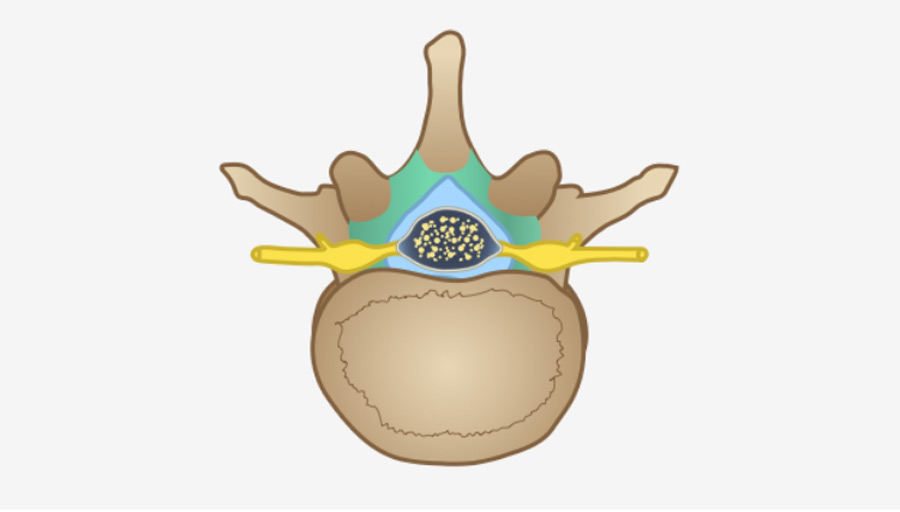The cause of your spinal stenosis influences your diagnosis and treatment options. In general, the cause of spinal stenosis can be categorized as either primary or acquired:
- Primary: Some people are simply born with a smaller spinal canal
- Acquired: You can also develop spinal stenosis over time due to wear and tear resulting in diseases like degenerative disc disease or injury, most often in patients between the ages of 50 and 70. This is because, as you age, the different parts of your spine can deteriorate.
Spinal stenosis has been referred to as the gray hair of the spine, meaning it’s often an age-related and gradual process of physical change. Here are some of the leading cause of acquired spinal stenosis:
Osteoarthritis of the spine (spondylosis) is the most common direct cause of spinal stenosis. The cartilage that cushions joints starts to degenerate due to age. It may become rough or wear through completely, allowing bones to rub against each other. The body reacts to this rubbing by producing small bone growths called bone spurs (osteophytes). That’s an effort to limit movement and pain from the bones rubbing together. In the spine, they can narrow the spinal canal (spinal stenosis), which may then compress your spinal cord or nerve roots.
Intervertebral disc problems, such as bulging, or ruptured or torn discs (herniated discs), can protrude into the spinal canal or pinch the nerve extending through the foramen.
Ligaments connecting the vertebrae may also degenerate, becoming stiff and thickened, and allow the vertebrae to shift or bulge, which can pinch the spinal cord or nerves.
Injury to the Spine can also cause spinal stenosis. For example, you may lift a heavy object without using proper lifting techniques. This can damage a disc or even move the vertebrae out of their normal alignment. Such injuries put pressure on the spinal cord and nerve roots. You could also fracture part of your spine, and the fragments of bone can intrude on the spinal canal. Any previous trauma to your spine, like dislocation or fractures of your vertebrae, can cause spinal stenosis. The displaced bone from these injuries can end up bulging into your spinal cord.
Note: Any new injury to the spine can cause tissue swelling that puts pressure on the spinal cord or nerve roots, leading to spinal stenosis and back or neck pain.
Symptoms
If you have spinal stenosis, your symptoms may develop gradually or suddenly. In general, the symptoms of spinal stenosis usually worsen over time. The pain can be a dull ache or a more sharp, severe pain. You may experience tingling, numbness, or muscle weakness in addition to any level of pain. Depending on where the stenosis of the spinal canal occurs and which nerves are affected, symptoms will vary.
Symptoms may include an inability to move without discomfort, pain or neurological signs, such as tingling sensations and numbness that may radiate into another part of your body.
The lumbar and cervical spinal levels are commonly affected by this progressive disorder.
Lumbar Spinal Stenosis Symptoms The most common symptom of lumbar spinal stenosis include pain in the lower back, buttocks and back of the thighs that worsens with standing and walking.
Some may experience symptoms only when they are standing or moving.
A common scenario for patients with lumbar spinal stenosis is that the discomfort or pain temporarily eases when you bend forward, sit, or lie down.
Other common symptoms:
Sciatica: pain, numbness, weakness or tingling sensations that radiate downward from the affected level in the lower back into the buttocks and legs. With sciatica, some patients experience pain in both legs, though one leg can be worse than the other.
Impaired Bowel & Bladder Function: In severe cases of lumbar spinal stenosis, nerves that control the bladder or bowel may be compressed, which can lead to partial or complete incontinence. If you have problems controlling your bladder or bowel, seek immediate medical attention.
Cervical Spinal Stenosis Symptoms The pain caused by cervical spinal stenosis may be described as acute, episodic, occasional, chronic: its intensity can vary from mild to severe.
Spinal stenosis in your neck can cause cervical radiculopathy—symptoms may include pain accompanied by tingling sensations, numbness or weakness. These symptoms may radiate downward from your neck into one or both shoulders, arms or hands.
Other symptoms may include:
- Headaches
- Difficulty with balance, an increased risk for falling
- Fine motor skills (such as handwriting or buttoning a shirt) may be affected
On the severe end of cervical spinal stenosis symptoms are those associated with cervical myelopathy. This occurs when the spinal canal narrows to the point that it compresses the spinal cord in your neck. While pinched nerves in your neck may affect your shoulders, arms or hands, myelopathy can involve your arms and legs, too.
Common symptoms of cervical myelopathy include neck pain, stiffness, tingling sensations, numbness, weakness, clumsiness, balance problems, difficulty walking, bowel or bladder problems and sexual dysfunction.
Sometimes, the symptoms of spinal stenosis can be treated through physical therapy and medication. For more chronic or severe symptoms, you may need surgery.

